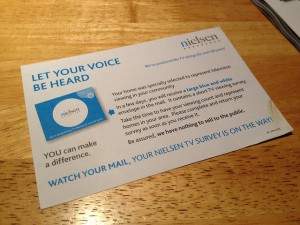14.5 Broadcast Audience Data
Likewise, broadcast audience data are available from the research service that collects and compiles ratings services. Nielsen collects information about television (broadcast, cable, computer and mobile) and radio audiences. The ratings information is used by a wide segment of mass communication professionals, not just advertisers.

The ratings volumes and reports generated by Nielsen include a wealth of data about the geographic markets surveyed, the demographic characteristics of the households and individuals surveyed, including:
-
the time of day when people watch television or listen to the radio.
-
the types of programs that attract the largest audiences.
-
the time spent by different types of people using broadcast media.
-
the device the person was using to watch or listen.
While it is not necessary for every communicator to learn to decode the data in the ratings volumes, it is important to understand how this information is used.
Ratings information determines the advertising rates charged by TV and radio stations, helps communicators understand something about the characteristics of media consumers, and gives a snapshot of the types of media programming that are popular or influential among audiences.
The Internet has become an important advertising medium and Nielsen, along with a number of new companies, provide “ratings” services for web and mobile advertising. These companies track usage of web and mobile sites based on things such as the number of unique visitors to a site on an hourly, daily, weekly or monthly basis, and they also can provide basic information about how users move around at a particular web or mobile site.
Many digital sites ask users to provide additional information about themselves, such as demographic information (income, family profiles, spending habits), and media professionals can combine that data with the tracking of site visits to provide advertisers with a powerful form of tailored audience measurement for this medium.

